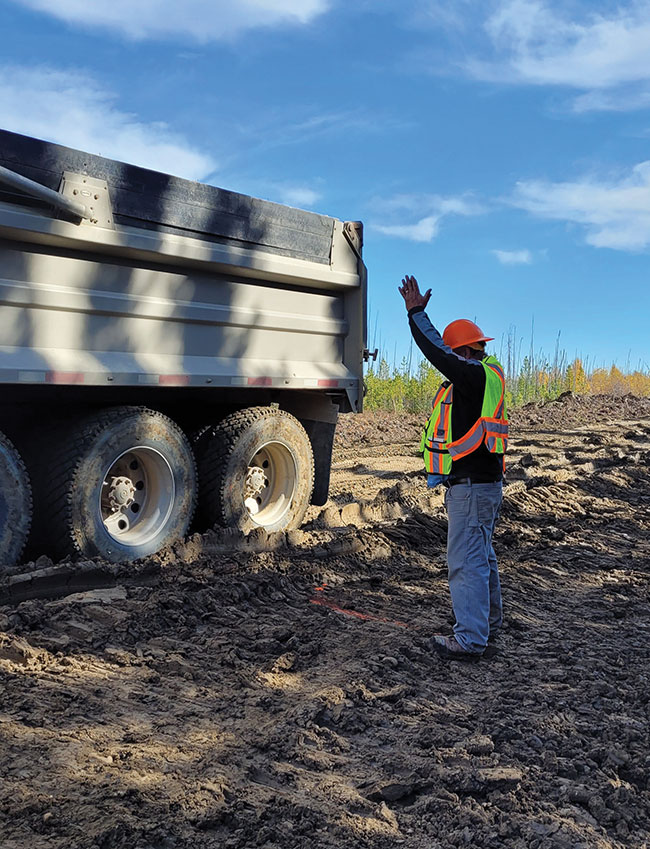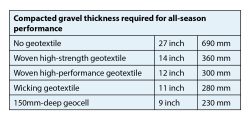
Features
Geosynthetics: Improving reliability of Canadian resource roads
November 24, 2022 By Allan Bradley and Francis Bober
 Unpaved resource roads provide forest management access. Photos courtesy of FPInnovations.
Unpaved resource roads provide forest management access. Photos courtesy of FPInnovations. Thousands of kilometres of unpaved resource roads are built each year by the Canadian forest sector to provide forest management access. These roads are experiencing reduced bearing capacity and more frequent access interruptions due to excess water in roadbeds; changes in climate and seasonal conditions; and sub-optimal construction, management, and maintenance practices. Two leading types of seasonal interruptions have been identified: those from weak, wet sections during the non-frozen seasons and those from temporarily thawed sections during winter months. These conditions create access bottlenecks which negatively impact transportation efficiency, fibre access, and costs. There is a need for solutions that will improve the reliability and resiliency of access under these difficult conditions which may get even more challenging in the future.
An FPInnovations survey of its members’ forest operations found that many have road structure issues and the range of strategies and technologies used to address these problems was limited. Most road managers rely on patching with gravel to temporarily strengthen weak spots and re-establish access. More effective but lesser-known technologies offer opportunities for more reliable access with potentially lower life cycle costs. Of these lesser-known technologies, and from a cost and ease-of-use perspective, FPInnovations selected geosynthetics as the most promising technology to perform research and implementation studies.
Typically, the forest industry builds its resource roads as economically as possible and accepts that these roads may fail a small amount of the time. This form of risk management relies heavily on the road builder’s experience and can become less accurate in the face of changing climate and operating practices. Making road designs stronger and more resilient by incorporating geosynthetics and design processes adds initial cost to the road construction. When a road section fails during a log haul, an emergency is declared, and the road must be repaired immediately and often without the usual cost constraints. These emergency repairs can easily be more costly than building the road to a higher initial standard, especially when the road failure caused mill disruptions and truck damage or if the road failures were multiple and ongoing. Life cycle costing of resource roads would capture this; however, this type of analysis is not often done. Designing to a higher initial standard may reduce the gravel requirements for building, repairing, and maintaining resource roads and this can be an important benefit, especially where good quality gravel is scarce.
 Geosynthetics are a proven solution for mechanically improving the performance of critically weak soils by providing reinforcement, confinement, drainage, separation, wicking, and filtration. Selection of the type of geosynthetic should be based upon performance attributes as well as cost and availability. For example, nonwoven geotextile is recommended as a separation layer to prolong the life of road gravels by preventing contamination by fines from the subgrade and preventing gravel loss into the subgrade. Where additional road strength is needed, a woven geotextile is more appropriate because it can provide the reinforcement, as well as separation and lateral drainage.
Geosynthetics are a proven solution for mechanically improving the performance of critically weak soils by providing reinforcement, confinement, drainage, separation, wicking, and filtration. Selection of the type of geosynthetic should be based upon performance attributes as well as cost and availability. For example, nonwoven geotextile is recommended as a separation layer to prolong the life of road gravels by preventing contamination by fines from the subgrade and preventing gravel loss into the subgrade. Where additional road strength is needed, a woven geotextile is more appropriate because it can provide the reinforcement, as well as separation and lateral drainage.
Some recommended practices for designing with and installing geotextiles include: a minimum six inches (150 mm) of cover is needed; high strength geotextile isn’t always needed for roading applications; overlapping geotextile edges allows tensile reinforcement across the overlap; geotextile designs typically require compaction of the gravel placed on top, and proper compaction, in turn, needs well graded granular material that is wetted to promote compaction; avoid driving heavy equipment on any geosynthetic as this can damage and weaken it; and, finally, remove sharp or large debris from the road surface before installing geotextiles to prevent their damage and to ease deployment.
FPInnovations has developed a guidebook for its members and their road-building contractors for designing resource roads for weak, wet conditions using geosynthetics. FPInnovations also offers an on-line geosynthetics tool (FPGeoDesign) which allows customized design scenarios and provides basic cost estimates. Using values from the guidebook, Table 1 illustrates the ability of geosynthetics to reduce gravel requirements for a resource road to be constructed on a wet, weak, clay subgrade.

Geocell reinforcement being installed at the FPInnovations test site.
FPInnovations, in collaboration with TenCate Geosynthetics, Presto Geosystems, and a forest company in northern Alberta, is conducting a comprehensive field study aimed at evaluating several geosynthetic technologies and evaluating their ability to improve road strength and stability during all seasons. A wet section on a resource road was selected to assess the effectiveness of geosynthetic products as compared with more conventional construction techniques. The site was divided into multiple test sections, each equipped with a unique combination of reinforcement technology and monitoring instrumentation. The effectiveness of these technologies will be monitored year-round for both summer performance (drainage and bearing capacity improvement) and winter performance (insulating ability). Performance will be compared to that of more conventionally constructed sections (one built with log and brush mat reinforcement [corduroy] and one built with just a roadbed of locally sourced granular material).
A report on this field work will be available early next year and be the subject of a paper presented at GeoCalgary 2022. This research is part of a larger work program by FPInnovations that looks into methods of increasing the resiliency and reliability of resource road access in the face of climate change.
Allan Bradley and Francis Bober are researchers for transportation and infrastructure at FPInnovations.
Print this page